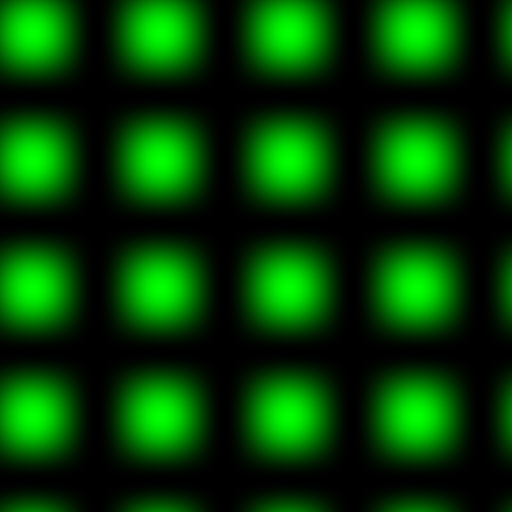以下CUDA sample是分别用C++和CUDA实现的生成的绿色的球图像,并对其中使用到的CUDA函数进行了解说,code参考了《GPU高性能编程CUDA实战》一书的第五章,各个文件内容如下:
funset.cpp:
#include "funset.hpp"
#include <random>
#include <iostream>
#include <vector>
#include <memory>
#include <string>
#include "common.hpp"
#include <opencv2/opencv.hpp>
int test_green_ball()
{
const int width{ 512 }, height = width;
cv::Mat mat1(height, width, CV_8UC4), mat2(height, width, CV_8UC4);
float elapsed_time1{ 0.f }, elapsed_time2{ 0.f }; // milliseconds
int ret = green_ball_cpu(mat1.data, width, height, &elapsed_time1);
if (ret != 0) PRINT_ERROR_INFO(green_ball_cpu);
ret = green_ball_gpu(mat2.data, width, height, &elapsed_time2);
if (ret != 0) PRINT_ERROR_INFO(green_ball_gpu);
for (int y = 0; y < height; ++y) {
for (int x = 0; x < width; ++x) {
cv::Vec4b val1 = mat1.at<cv::Vec4b>(y, x);
cv::Vec4b val2 = mat2.at<cv::Vec4b>(y, x);
for (int i = 0; i < 4; ++i) {
if (val1[i] != val2[i]) {
fprintf(stderr, "their values are different at (%d, %d), i: %d, val1: %d, val2: %d\n",
x, y, i, val1[i], val2[i]);
//return -1;
}
}
}
}
const std::string save_image_name{ "E:/GitCode/CUDA_Test/gree_ball.jpg" };
cv::imwrite(save_image_name, mat2);
fprintf(stderr, "test green ball: cpu run time: %f ms, gpu run time: %f ms\n", elapsed_time1, elapsed_time2);
return 0;
}#include "funset.hpp"
#include <chrono>
#include "common.hpp"
int green_ball_cpu(unsigned char* ptr, int width, int height, float* elapsed_time)
{
auto start = std::chrono::steady_clock::now();
const float period{ 128.0f };
for (int y = 0; y < height; ++y) {
for (int x = 0; x < width; ++x) {
int offset = x + y * width;
unsigned char grey = (unsigned char)(255 * (sinf(x * 2.0f * PI / period) + 1.0f) *
(sinf(y * 2.0f * PI / period) + 1.0f) / 4.0f) ;
ptr[offset * 4 + 0] = 0;
ptr[offset * 4 + 1] = grey;
ptr[offset * 4 + 2] = 0;
ptr[offset * 4 + 3] = 255;
}
}
auto end = std::chrono::steady_clock::now();
auto duration = std::chrono::duration_cast<std::chrono::nanoseconds>(end - start);
*elapsed_time = duration.count() * 1.0e-6;
return 0;
}#include "funset.hpp"
#include <iostream>
#include <algorithm>
#include <memory>
#include <cuda_runtime.h> // For the CUDA runtime routines (prefixed with "cuda_")
#include <device_launch_parameters.h>
#include "common.hpp"
/* __global__: 函数类型限定符;在设备上运行;在主机端调用,计算能力3.2及以上可以在
设备端调用;声明的函数的返回值必须是void类型;对此类型函数的调用是异步的,即在
设备完全完成它的运行之前就返回了;对此类型函数的调用必须指定执行配置,即用于在
设备上执行函数时的grid和block的维度,以及相关的流(即插入<<< >>>运算符);
a kernel,表示此函数为内核函数(运行在GPU上的CUDA并行计算函数称为kernel(内核函
数),内核函数必须通过__global__函数类型限定符定义); */
__global__ static void green_ball(unsigned char* ptr, int width, int height)
{
/* gridDim: 内置变量,用于描述线程网格的维度,对于所有线程块来说,这个
变量是一个常数,用来保存线程格每一维的大小,即每个线程格中线程块的数量.
一个grid最多只有二维,为dim3类型;
blockDim: 内置变量,用于说明每个block的维度与尺寸.为dim3类型,包含
了block在三个维度上的尺寸信息;对于所有线程块来说,这个变量是一个常数,
保存的是线程块中每一维的线程数量;
blockIdx: 内置变量,变量中包含的值就是当前执行设备代码的线程块的索引;用
于说明当前thread所在的block在整个grid中的位置,blockIdx.x取值范围是
[0,gridDim.x-1],blockIdx.y取值范围是[0, gridDim.y-1].为uint3类型,
包含了一个block在grid中各个维度上的索引信息;
threadIdx: 内置变量,变量中包含的值就是当前执行设备代码的线程索引;用于
说明当前thread在block中的位置;如果线程是一维的可获取threadIdx.x,如果
是二维的还可获取threadIdx.y,如果是三维的还可获取threadIdx.z;为uint3类
型,包含了一个thread在block中各个维度的索引信息 */
// map from threadIdx/BlockIdx to pixel position
int x = threadIdx.x + blockIdx.x * blockDim.x;
int y = threadIdx.y + blockIdx.y * blockDim.y;
int offset = x + y * blockDim.x * gridDim.x;
/* __shared__: 变量类型限定符;使用__shared__限定符,或者与__device__限
定符连用,此时声明的变量位于block中的共享存储器空间中,与block具有相同
的生命周期,仅可通过block内的所有线程访问;__shared__和__constant__变量
默认为是静态存储;在__shared__前可以加extern关键字,但表示的是变量大小
由执行参数确定;__shared__变量在声明时不能初始化;可以将CUDA C的关键字
__shared__添加到变量声明中,这将使这个变量驻留在共享内存中;CUDA C编译
器对共享内存中的变量与普通变量将分别采取不同的处理方式 */
__shared__ float shared[16][16]; // == threads_block
// now calculate the value at that position
const float period = 128.0f;
shared[threadIdx.x][threadIdx.y] = 255 * (sinf(x*2.0f*PI / period) + 1.0f) *(sinf(y*2.0f*PI / period) + 1.0f) / 4.0f;
/* __syncthreads: 对线程块中的线程进行同步;CUDA架构将确保,除非线程块
中的每个线程都执行了__syncthreads(),否则没有任何线程能执行
__syncthreads()之后的指令;在同一个block中的线程通过共享存储器(shared
memory)交换数据,并通过栅栏同步(可以在kernel函数中需要同步的位置调用
__syncthreads()函数)保证线程间能够正确地共享数据;使用clock()函数计时,
在内核函数中要测量的一段代码的开始和结束的位置分别调用一次clock()函数,
并将结果记录下来。由于调用__syncthreads()函数后,一个block中的所有
thread需要的时间是相同的,因此只需要记录每个block执行需要的时间就行了,
而不需要记录每个thread的时间 */
// removing this syncthreads shows graphically what happens
// when it doesn't exist.this is an example of why we need it.
__syncthreads();
ptr[offset * 4 + 0] = 0;
ptr[offset * 4 + 1] = shared[/*15 - */threadIdx.x][/*15 - */threadIdx.y];
ptr[offset * 4 + 2] = 0;
ptr[offset * 4 + 3] = 255;
}
int green_ball_gpu(unsigned char* ptr, int width, int height, float* elapsed_time)
{
/* cudaEvent_t: CUDA event types,结构体类型, CUDA事件,用于测量GPU在某
个任务上花费的时间,CUDA中的事件本质上是一个GPU时间戳,由于CUDA事件是在
GPU上实现的,因此它们不适于对同时包含设备代码和主机代码的混合代码计时 */
cudaEvent_t start, stop;
// cudaEventCreate: 创建一个事件对象,异步启动
cudaEventCreate(&start);
cudaEventCreate(&stop);
// cudaEventRecord: 记录一个事件,异步启动,start记录起始时间
cudaEventRecord(start, 0);
const size_t length{ width * height * 4 * sizeof(unsigned char) };
unsigned char* dev{ nullptr };
// cudaMalloc: 在设备端分配内存
cudaMalloc(&dev, length);
const int threads_block{ 16 };
dim3 blocks(width / threads_block, height / threads_block);
dim3 threads(threads_block, threads_block);
/* <<< >>>: 为CUDA引入的运算符,指定线程网格和线程块维度等,传递执行参
数给CUDA编译器和运行时系统,用于说明内核函数中的线程数量,以及线程是如何
组织的;尖括号中这些参数并不是传递给设备代码的参数,而是告诉运行时如何
启动设备代码,传递给设备代码本身的参数是放在圆括号中传递的,就像标准的函
数调用一样;不同计算能力的设备对线程的总数和组织方式有不同的约束;必须
先为kernel中用到的数组或变量分配好足够的空间,再调用kernel函数,否则在
GPU计算时会发生错误,例如越界等;
使用运行时API时,需要在调用的内核函数名与参数列表直接以<<<Dg,Db,Ns,S>>>
的形式设置执行配置,其中:Dg是一个dim3型变量,用于设置grid的维度和各个
维度上的尺寸.设置好Dg后,grid中将有Dg.x*Dg.y个block,Dg.z必须为1;Db是
一个dim3型变量,用于设置block的维度和各个维度上的尺寸.设置好Db后,每个
block中将有Db.x*Db.y*Db.z个thread;Ns是一个size_t型变量,指定各块为此调
用动态分配的共享存储器大小,这些动态分配的存储器可供声明为外部数组
(extern __shared__)的其他任何变量使用;Ns是一个可选参数,默认值为0;S为
cudaStream_t类型,用于设置与内核函数关联的流.S是一个可选参数,默认值0. */
green_ball << <blocks, threads >> >(dev, width, height);
/* cudaMemcpy: 在主机端和设备端拷贝数据,此函数第四个参数仅能是下面之一:
(1). cudaMemcpyHostToHost: 拷贝数据从主机端到主机端
(2). cudaMemcpyHostToDevice: 拷贝数据从主机端到设备端
(3). cudaMemcpyDeviceToHost: 拷贝数据从设备端到主机端
(4). cudaMemcpyDeviceToDevice: 拷贝数据从设备端到设备端
(5). cudaMemcpyDefault: 从指针值自动推断拷贝数据方向,需要支持
统一虚拟寻址(CUDA6.0及以上版本)
cudaMemcpy函数对于主机是同步的 */
cudaMemcpy(ptr, dev, length, cudaMemcpyDeviceToHost);
// cudaFree: 释放设备上由cudaMalloc函数分配的内存
cudaFree(dev);
// cudaEventRecord: 记录一个事件,异步启动,stop记录结束时间
cudaEventRecord(stop, 0);
// cudaEventSynchronize: 事件同步,等待一个事件完成,异步启动
cudaEventSynchronize(stop);
// cudaEventElapseTime: 计算两个事件之间经历的时间,单位为毫秒,异步启动
cudaEventElapsedTime(elapsed_time, start, stop);
// cudaEventDestroy: 销毁事件对象,异步启动
cudaEventDestroy(start);
cudaEventDestroy(stop);
return 0;
}























 1142
1142

 被折叠的 条评论
为什么被折叠?
被折叠的 条评论
为什么被折叠?








